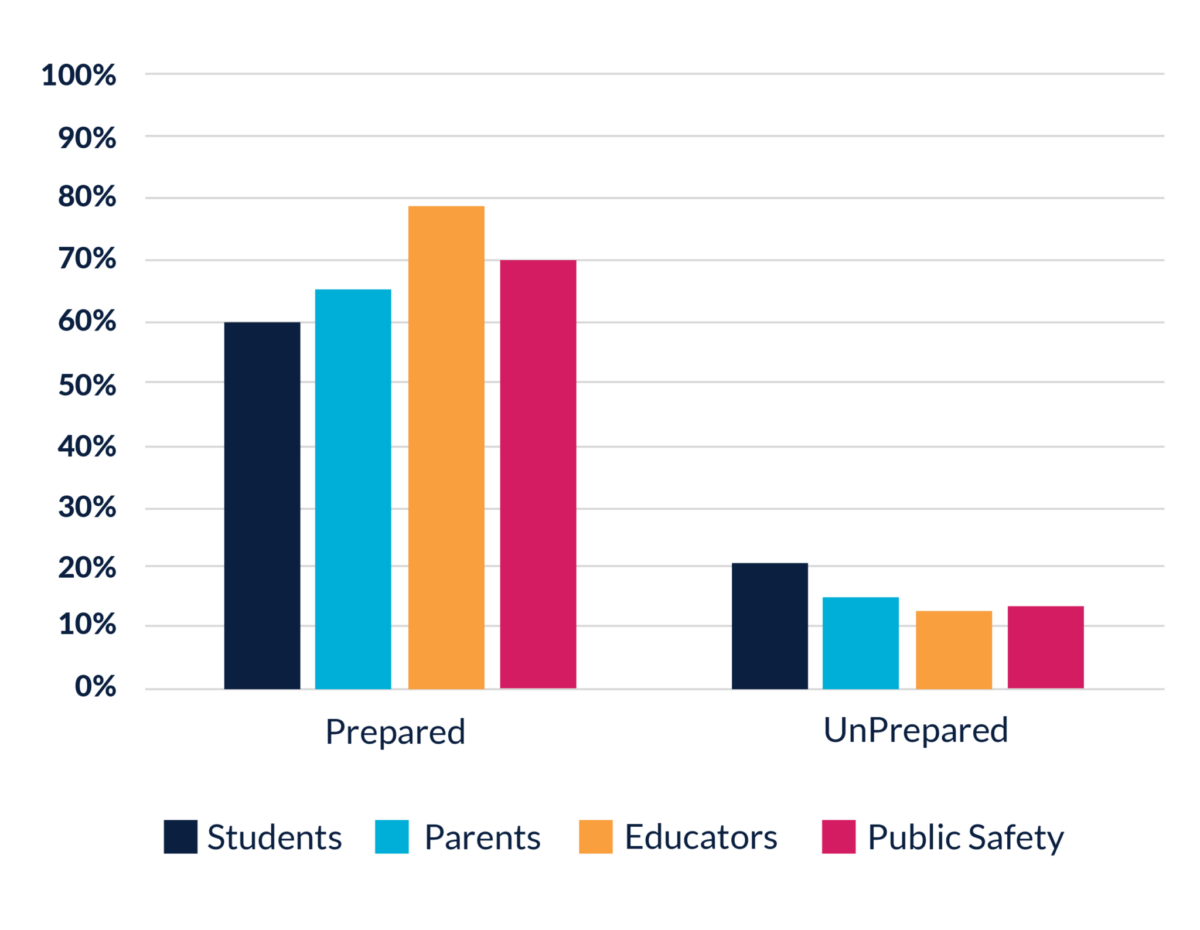Nearly a Third of Students Surveyed Don’t Feel Safe at School
The 2022 State of School Safety Report found that nearly one-third of students don’t feel safe at school and noted a perceived rise in substance abuse, depression, and anxiety among students.
Safe and Sound Schools, together with Lightspeed Systems® and Raptor Technologies, surveyed nearly 2,600 students, parents, administrators, and student resource officers nationwide to understand the current state of school safety. And while most stakeholders surveyed feel schools are safe, students feel less confident about school safety than all other groups. This disconnect reveals a need for community-wide conversations and outreach to increase knowledge, engagement, and confidence for all members of the school community.
“Now more than ever, it is critical that school communities engage all stakeholders—from students to superintendents—in conversation and decision-making to protect our most sacred spaces and precious community members, our schools and our students,” said Michele Gay, Co-Founder and Executive Director of Safe and Sound Schools.
To better understand these concerns, why they differ, and how to move forward toward safer, more secure schools, read on for highlights from the 2022 State of School Safety Report.
Mental health is on everyone’s mind
For those surveyed, mental health was a top concern.
Eighty-three percent of educators reported feeling that their school or district is prepared in the event of a mental health issue or crisis, compared to 73% of public safety respondents. This contrasts significantly with parents and students: only 66% of parents and 61% of students said their school is prepared for a mental health crisis. The data suggests there are clear differences in perception, and perhaps satisfaction, with the level of mental health crisis preparedness, training, and resources available at schools.
In addition, Steven Langford, CIO at Beaverton School District in Oregon, pointed out that students don’t just use their personal devices for games and social networking at all hours of the day—they also use them to learn.
That can create additional opportunities for engagement, but it also creates issues of equity for students and schools that don’t have access to the same online resources or devices as wealthier schools. Langford noted that when discussing improving efficacy and engagement, you can’t leave equity out of the conversation.

When asked what additional programs they wanted in their schools, many study participants responded that they wanted expanded mental health services, such as mental health counseling and mental wellness programs. This was desired not just for students, but also for staff who have exhibited an unprecedented rise in anxiety and depression.
Ways to combat mental health issues
“Students are telling us: they need more help,” said Brian Thomas, CEO of Lightspeed Systems. “We know bullying and other social challenges commonly predicate violence and self-harm or exacerbate depression and anxiety. Together we must listen to our students, identify the early warning signs, and intervene before students cause harm to themselves or others.”
Online monitoring software is a viable solution to help educators identify students in crisis. Solutions like Lightspeed Alert™ monitor for online indicators of threats of harm to self and others, and alerts are instantly sent to designated personnel at the school and district levels to help enable intervention before an incident occurs.
Another way schools can help is through social-emotional learning, or SEL. Encompassing concepts like anxiety management, healthy relationships, problem-solving, conflict resolution, and empathy, SEL gives students the tools to improve their mental health while also helping them build better relationships.
SEL doesn’t have to be an entirely separate curriculum in schools. Educators and SROs can incorporate these concepts into their existing lessons and conversations and use their healthy partnerships with other adults at the school as a model for students.
Providing information and tips to parents about how to effectively communicate with their children about mental health issues is also important.
SROs, school psychologists, school counselors, social workers, parents, and educators teaching the concepts of SEL are all working toward the same goals: student safety, health, and security. When these parties work together to address both physical and psychological safety, the greatest results are achieved.

Identify the gaps between students, teachers, and SROs
One takeaway from the 2022 State of School Safety Report—and reports in years past—is there is a disconnect between what work is being done to keep schools safe and how school environments are perceived. The data suggests that students have a lack of confidence and/or knowledge of the safety preparedness efforts at their school. In addition, the report indicated a trend that educators feel prepared for a wide variety of safety situations, but students and parents don’t.
The new report also showed a gap between teachers and SROs. Teachers are more overextended and stressed than ever, and it may be hard for them to keep up with the complex workings of their district’s safety program.
A similar disconnect exists between how adults and students see school safety, with students feeling much less secure. Only 68% of students reported feeling safe at school compared to 87% of educators who feel school is a safe place to be, suggesting there is more schools can do to help students feel safe.
Bridge the gaps between students, teachers, and SROs
Getting everyone on the same page and making sure that teachers are aware of safety programs and procedures is vital to the success of a district’s safety programs.
Consistent, positive engagement with students by SROs can also help students feel safer. Regularly have conversations with students about whether they feel safe. If they don’t, ask them about what specific interactions, situations, or places are the source(s) of the problem.
Kids have access to an endless supply of news updates, online information, and social media about real and perceived threats, but adults can push back against that with daily, in-person reassurance about what is being done in their schools and communities to keep students safe.

Bullying continues to be a concern
Bullying has come to encompass a wide range of activities and behaviors, including cyberbullying. And though bullying has been a concern for decades, only 60% of students believe schools have the tools to address this behavior. This suggests more can be done to improve school bullying prevention policies and procedures.
Even before the pandemic, cyberbullying was a rapidly growing source of concern. After years of hybrid and remote learning, that risk has only grown. Online communication provides students with unprecedented access to each other, the ability to easily gang up on one another, and the possibility of anonymous harassment.
Strategies K-12 schools can use to address bullying
To address this, a good first step is to break down the umbrella term “bullying” into behaviors. This can help pinpoint and differentiate between what’s happening among the wide range of activities that may feel like bullying to students—including peer conflict and miscommunication—and actual bullying. When educators and parents accurately understand the behavior in question, they can more effectively help students address bullying.
Other strategies schools can use to reduce bullying include:
- Increasing adult presence and supervision and mechanisms for reporting abuse
- Developing multi-tiered support systems to ensure a continuum of universal, targeted, and intensive support
- Leveraging software to stop cyberbullying on social media and flag terms related to cyberbullying
SROs can help, too. While SROs might concentrate most of their attention on threats of violence on campus, bullying, cyberbullying, sextortion, trafficking, and related issues also fall under the heading of “school safety.” SROs can help by having conversations with students about safe behavior, healthy relationships, and good digital citizenship.
To learn more, download the full report: 2022 State of School Safety Report. It offers detailed insights, actionable data, and recommendations to keep students safe at school.

